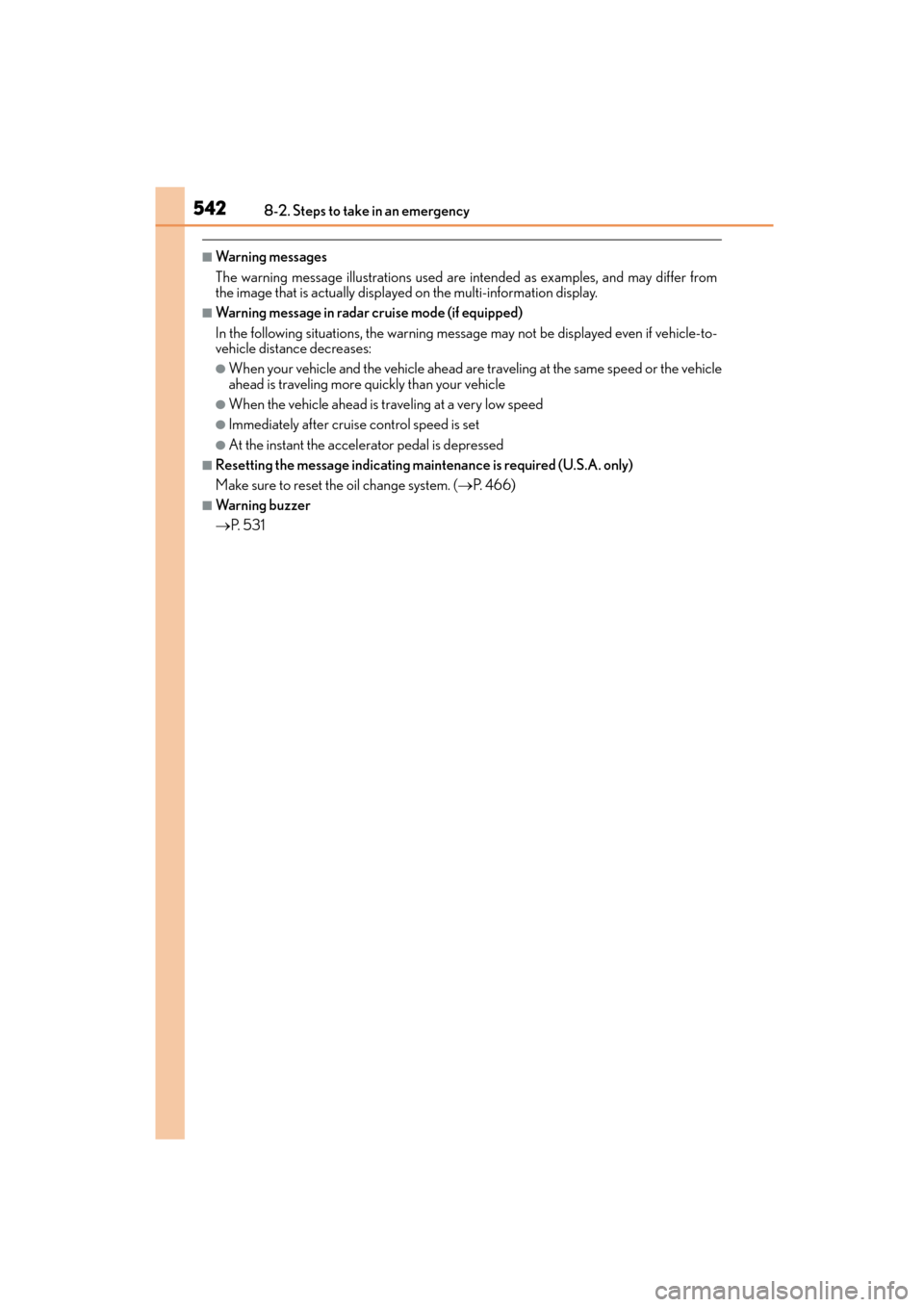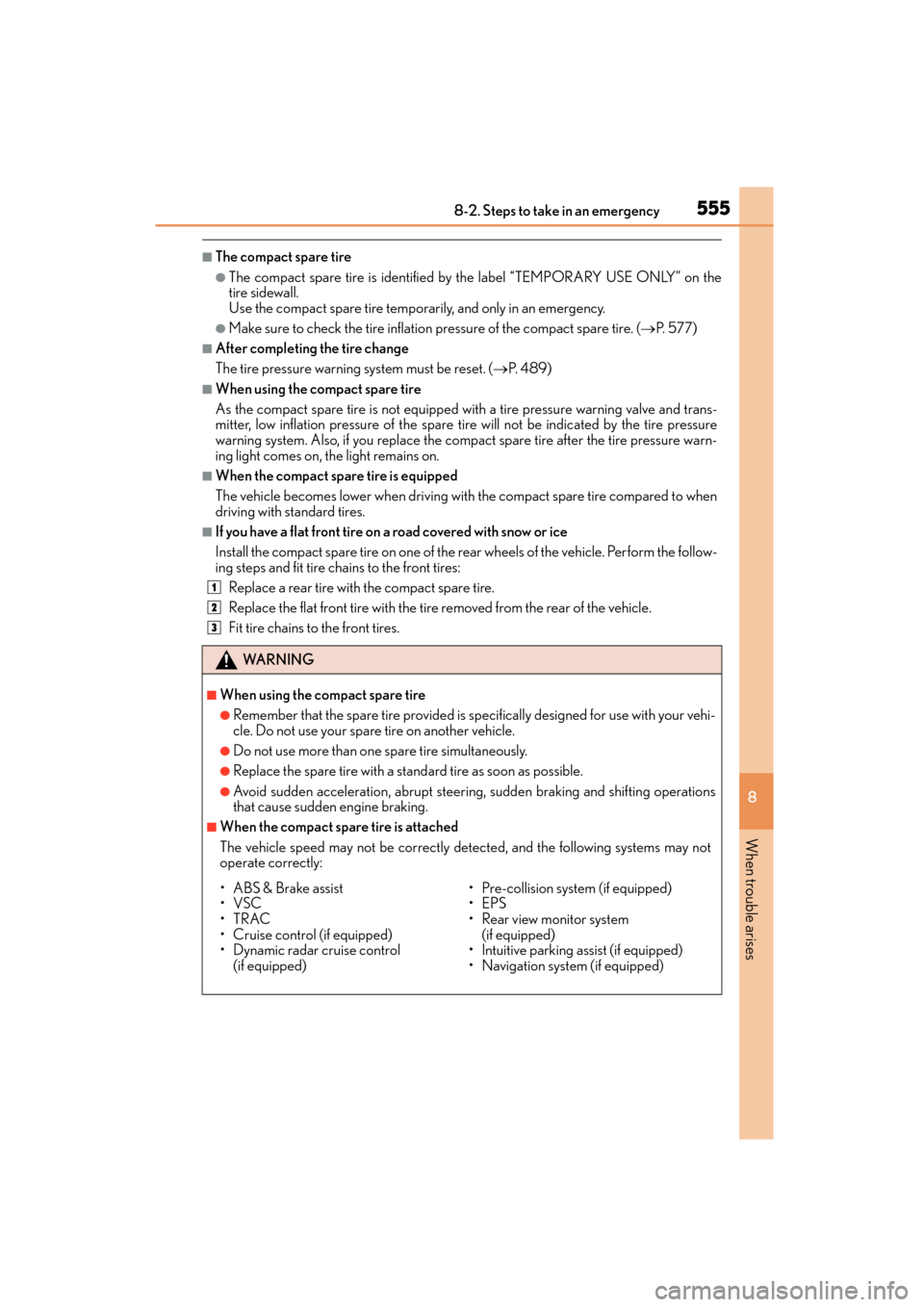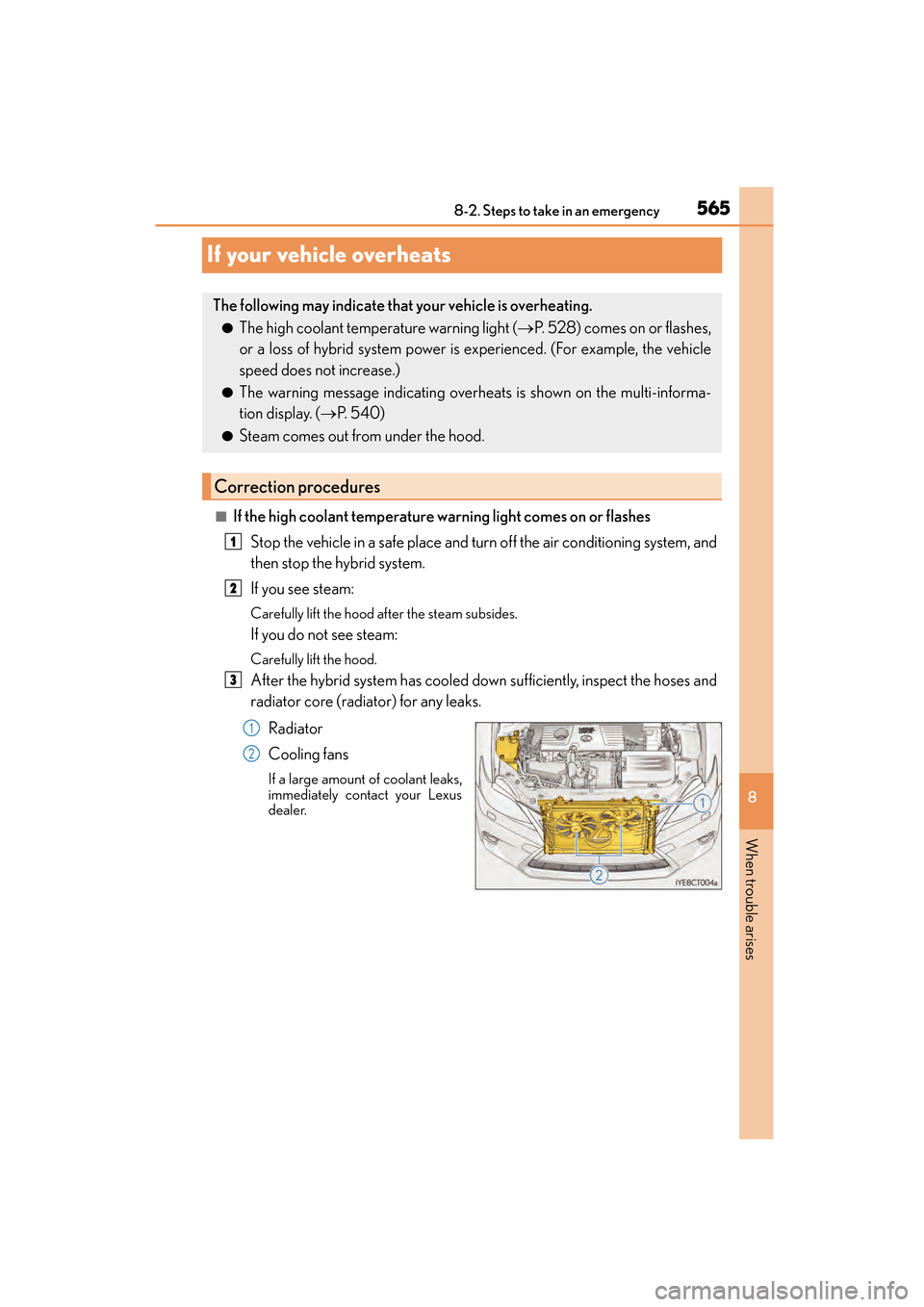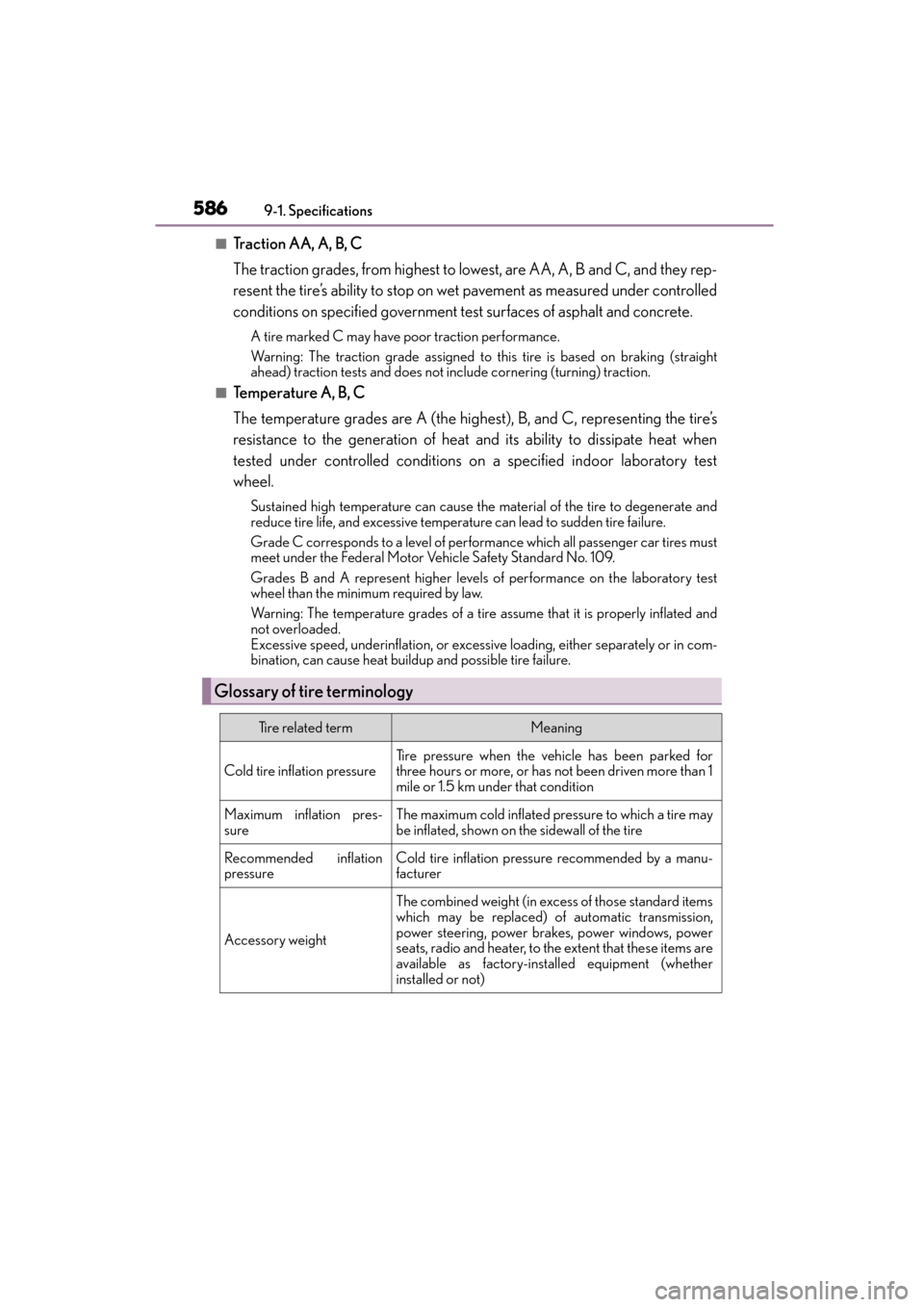warning Lexus CT200h 2015 (in English) Repair Manual
[x] Cancel search | Manufacturer: LEXUS, Model Year: 2015, Model line: CT200h, Model: Lexus CT200h 2015Pages: 634
Page 533 of 634

5328-2. Steps to take in an emergency
CT200h_OM_OM76174U_(U)
WA R N I N G
■If both the ABS and the brake system warning lights remain on
Stop your vehicle in a safe place immediately and contact your Lexus dealer. The vehi-
cle will become extremely unstable during braking, and the ABS system may fail, which
could cause an accident resulting in death or serious injury.
■When the electric power steering system warning light comes on
The steering wheel may become extremely heavy.
If the steering wheel becomes heavier than usual when operating, hold firmly and oper-
ate using more force than usual.
■If the tire pressure warning light comes on
Be sure to observe the following precautions. Failure to do so could cause a loss of
vehicle control and result in death or serious injury.
●Stop your vehicle in a safe place as soon as possible. Adjust the tire inflation pressure
immediately.
●If the tire pressure warning light comes on even after tire inflation pressure adjust-
ment, it is probable that you have a flat tire. Check the tires. If a tire is flat, change it
with the spare tire and have the flat tire repaired by the nearest Lexus dealer.
●Avoid abrupt maneuvering and braking. If the vehicle tires deteriorate, you could lose
control of the steering wheel or the brakes.
■If a blowout or sudden air leakage should occur
The tire pressure warning system may not activate immediately.
Page 534 of 634

5338-2. Steps to take in an emergency
CT200h_OM_OM76174U_(U)
8
When trouble arises
WA R N I N G
■Maintenance of the tires
Each tire, including the spare (if provided), should be checked monthly when cold and
inflated to the inflation pressure recommended by the vehicle manufacturer on the
vehicle placard or tire inflation pressure label (tire and load information label). (If your
vehicle has tires of a different size than the size indicated on the vehicle placard or tire
inflation pressure label [tire and load in formation label], you should determine the
proper tire inflation pressure for those tires.)
As an added safety feature, your vehicle has been equipped with a tire pressure moni-
toring system (TPMS-tire pressure warning system) that illuminates a low tire pressure
telltale (tire pressure warning light) when on e or more of your tires is significantly
under-inflated. Accordingly, when the low ti re pressure telltale (tire pressure warning
light) illuminates, you should stop and check yo ur tires as soon as possible, and inflate
them to the proper pressure. Driving on a significantly under-inflated tire causes the
tire to overheat and can lead to tire failure. Under-inflation also reduces fuel efficiency
and tire tread life, and may affect the vehicle’s handling and stopping ability.
Please note that the TPMS (tire pressure warning system) is not a substitute for proper
tire maintenance, and it is the driver’s responsibility to maintain correct tire pressure,
even if under-inflation has not reached the level to trigger illumination of the TPMS low
tire pressure telltale (tire pressure warning light).
Your vehicle has also been equipped with a TPMS (tire pressure warning system) mal-
function indicator to indicate when the system is not operating properly. The TPMS
(tire pressure warning system) malfunction indicator is combined with the low tire pres-
sure telltale (tire pressure warning light). When the system detects a malfunction, the
telltale will flash for approximately one minu te and then remain continuously illumi-
nated. This sequence will continue upon su bsequent vehicle start-ups as long as the
malfunction exists. When the malfunction indicator is illuminated, the system may not
be able to detect or signal low tire pressure as intended.
TPMS (tire pressure warning system) malfunctions may occur for a variety of reasons,
including the installation of replacement or alternate tires or wheels on the vehicle that
prevent the TPMS (tire pressure warning system) from functioning properly. Always
check the TPMS (tire pressure warning syst em) malfunction telltale after replacing one
or more tires or wheels on your vehicle to ensure that the replacement or alternate
tires and wheels allow the TPMS (tire pressure warning system) to continue to function
properly.
NOTICE
■To ensure the tire pressure warning system operates properly
Do not install tires with different specifications or makers, as the tire pressure warning
system may not operate properly.
Page 535 of 634

534
CT200h_OM_OM76174U_(U)8-2. Steps to take in an emergency
If a warning message is displayed
Master warning light
The master warning light also comes
on or flashes in order to indicate that
a message is currently being dis-
played on the multi-information dis-
play.
Multi-information display
If any of the warning lights come on ag ain after the following actions have been
performed, contact your Lexus dealer.
If a warning is shown on the multi-information display, stay calm and perform
the following actions:
1
2
Page 536 of 634

5358-2. Steps to take in an emergency
CT200h_OM_OM76174U_(U)
8
When trouble arises
Warning message and warning buzzer list
Wa r n i n g m e s s a g eDetails/Actions
(If equipped)
Indicates that:
• There is a high possibility of a frontal collision; or
• The pre-collision braking function is operating A buzzer also sounds.
→ Slow the vehicle by applying the brakes.
(Flashes)
(If equipped)
Indicates that your vehicle is nearing the vehicle ahead
(in vehicle-to-vehicle distance control mode) A buzzer also sounds.
→ Slow the vehicle by applying the brakes.
Indicates that the driver’s door was opened with the shift
position in any position other than P
A buzzer also sounds.
→ Shift the shift position to P.
Indicates that one or more of the doors is not fully closed
The system also indicates which doors are not fully
closed.
If the vehicle reaches a speed of 3 mph (5 km/h), a
buzzer sounds to indicate that the door(s) are not yet
fully closed.
→ Make sure that all the doors are closed.
Indicates that the hood is not fully closed
→Close the hood.
Indicates that the back door is not fully closed
If the vehicle reaches a speed of 3 mph (5 km/h), a
buzzer sounds to indicate that the back door is not yet
fully closed.
→ Close the back door.
(Flashes
rapidly)
(Flashes)
Page 543 of 634

5428-2. Steps to take in an emergency
CT200h_OM_OM76174U_(U)
■Wa r n i n g m e s s a g e s
The warning message illustrations used are intended as examples, and may differ from
the image that is actually displaye d on the multi-information display.
■Warning message in radar cruise mode (if equipped)
In the following situations, the warning message may not be displayed even if vehicle-to-
vehicle distance decreases:
●When your vehicle and the vehicle ahead are traveling at the same speed or the vehicle
ahead is traveling more quickly than your vehicle
●When the vehicle ahead is traveling at a very low speed
●Immediately after cruise control speed is set
●At the instant the accelerator pedal is depressed
■Resetting the message indicating maintenance is required (U.S.A. only)
Make sure to reset the oil change system. ( →P. 4 6 6 )
■Warning buzzer
→P. 5 3 1
Page 547 of 634

5468-2. Steps to take in an emergency
CT200h_OM_OM76174U_(U)
■Wa r n i n g m e s s a g e s
→P. 5 4 2
■Warning buzzer
→P. 5 3 1
Once
An attempt was made to start the
hybrid system with the shift position
in N.
→ Shift the shift position to P and
start the hybrid system.
OnceThe electronic key has a low battery.
→Replace the electronic key bat-
tery. ( →P. 5 0 2 )
Interior
buzzerExteriorbuzzerWa r n i n g m e s s a g eDetails/Actions
(Flashes)
Page 556 of 634

5558-2. Steps to take in an emergency
CT200h_OM_OM76174U_(U)
8
When trouble arises
■The compact spare tire
●The compact spare tire is identified by the label “TEMPORARY USE ONLY” on the
tire sidewall.
Use the compact spare tire temporarily, and only in an emergency.
●Make sure to check the tire inflation pressure of the compact spare tire. ( →P. 577)
■After completing the tire change
The tire pressure warning system must be reset. ( →P. 4 8 9 )
■When using the compact spare tire
As the compact spare tire is not equipped with a tire pressure warning valve and trans-
mitter, low inflation pressure of the spare tire will not be indicated by the tire pressure
warning system. Also, if you replace the compact spare tire after the tire pressure warn-
ing light comes on, the light remains on.
■When the compact spare tire is equipped
The vehicle becomes lower when driving with the compact spare tire compared to when
driving with standard tires.
■If you have a flat front tire on a road covered with snow or ice
Install the compact spare tire on one of the rear wheels of the vehicle. Perform the follow-
ing steps and fit tire chains to the front tires:
Replace a rear tire with the compact spare tire.
Replace the flat front tire with the tire removed from the rear of the vehicle.
Fit tire chains to the front tires.
WA R N I N G
■When using the compact spare tire
●Remember that the spare tire provided is specifically designed for use with your vehi-
cle. Do not use your spare tire on another vehicle.
●Do not use more than one spare tire simultaneously.
●Replace the spare tire with a standard tire as soon as possible.
●Avoid sudden acceleration, abrupt steering, sudden braking and shifting operations
that cause sudden engine braking.
■When the compact spare tire is attached
The vehicle speed may not be correctly detected, and the following systems may not
operate correctly:
1
2
3
• ABS & Brake assist
•VSC
•TRAC
• Cruise control (if equipped)
• Dynamic radar cruise control (if equipped) • Pre-collision system (if equipped)
•EPS
• Rear view monitor system
(if equipped)
• Intuitive parking assist (if equipped)
• Navigation system (if equipped)
Page 566 of 634

565
CT200h_OM_OM76174U_(U)
8
When trouble arises
8-2. Steps to take in an emergency
If your vehicle overheats
■If the high coolant temperature warning light comes on or flashes
Stop the vehicle in a safe place and turn off the air conditioning system, and
then stop the hybrid system.
If you see steam:
Carefully lift the hood after the steam subsides.
If you do not see steam:
Carefully lift the hood.
After the hybrid system has cooled down sufficiently, inspect the hoses and
radiator core (radiator) for any leaks.
Radiator
Cooling fans
If a large amount of coolant leaks,
immediately contact your Lexus
dealer.
The following may indicate that your vehicle is overheating.
●The high coolant temper ature warning light (→P. 528) comes on or flashes,
or a loss of hybrid system power is experienced. (For example, the vehicle
speed does not increase.)
●The warning message indicating overheats is shown on the multi-informa-
tion display. ( →P. 5 4 0 )
●Steam comes out from under the hood.
Correction procedures
1
2
3
1
2
Page 568 of 634

5678-2. Steps to take in an emergency
CT200h_OM_OM76174U_(U)
8
When trouble arises
■If the warning message indicating overheats is shown on the multi-informa-
tion display Stop the vehicle in a safe place.
Stop the hybrid system and carefully lift the hood.
After the hybrid system has cooled down, inspect the hoses and radiator
core (radiator) for any leaks.
Radiator
Cooling fans
If a large amount of coolant leaks,
immediately contact your Lexus
dealer.
The coolant level is satisfactory if it is between the “FULL” and “LOW” lines
on the reservoir.Reservoir
“FULL” line
“LOW” line
Add coolant if necessary.
Water can be used in an emergency
if coolant is unavailable.
1
2
3
1
2
4
1
2
3
5
Page 587 of 634

586
CT200h_OM_OM76174U_(U)9-1. Spec
ifications
■Traction AA, A, B, C
The traction grades, from highest to lowest, are AA, A, B and C, and they rep-
resent the tire’s ability to stop on wet pavement as measured under controlled
conditions on specified government test surfaces of asphalt and concrete.
A tire marked C may have poor traction performance.
Warning: The traction grade assigned to th is tire is based on braking (straight
ahead) traction tests and does not include cornering (turning) traction.
■Temperature A, B, C
The temperature grades are A (the highest), B, and C, representing the tire’s
resistance to the generation of heat and its ability to dissipate heat when
tested under controlled conditions on a specified indoor laboratory test
wheel.
Sustained high temperature can cause the material of the tire to degenerate and
reduce tire life, and excessive temperature can lead to sudden tire failure.
Grade C corresponds to a level of performance which all passenger car tires must
meet under the Federal Motor Vehicle Safety Standard No. 109.
Grades B and A represent higher levels of performance on the laboratory test
wheel than the minimum required by law.
Warning: The temperature grades of a tire assume that it is properly inflated and
not overloaded.
Excessive speed, underinflation, or excessive loading, either separately or in com-
bination, can cause heat buildup and possible tire failure.
Glossary of tire terminology
Tire related termMeaning
Cold tire inflation pressureTire pressure when the vehicle has been parked for
three hours or more, or has not been driven more than 1
mile or 1.5 km under that condition
Maximum inflation pres-
sureThe maximum cold inflated pressure to which a tire may
be inflated, shown on the sidewall of the tire
Recommended inflation
pressureCold tire inflation pressure recommended by a manu-
facturer
Accessory weight
The combined weight (in excess of those standard items
which may be replaced) of automatic transmission,
power steering, power brakes, power windows, power
seats, radio and heater, to the extent that these items are
available as factory-installed equipment (whether
installed or not)